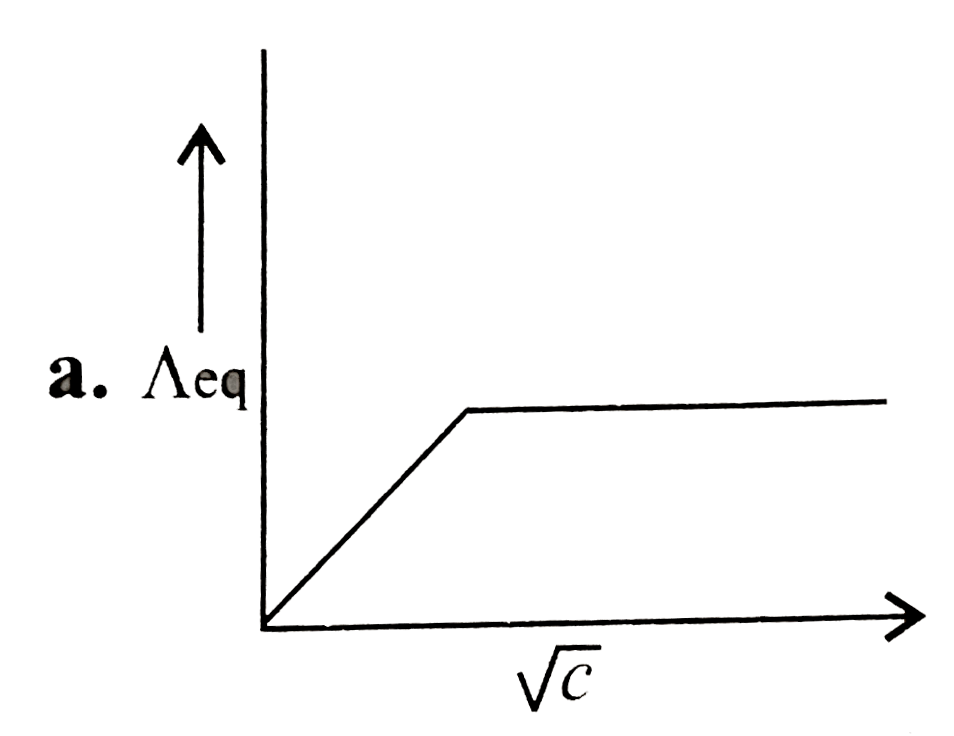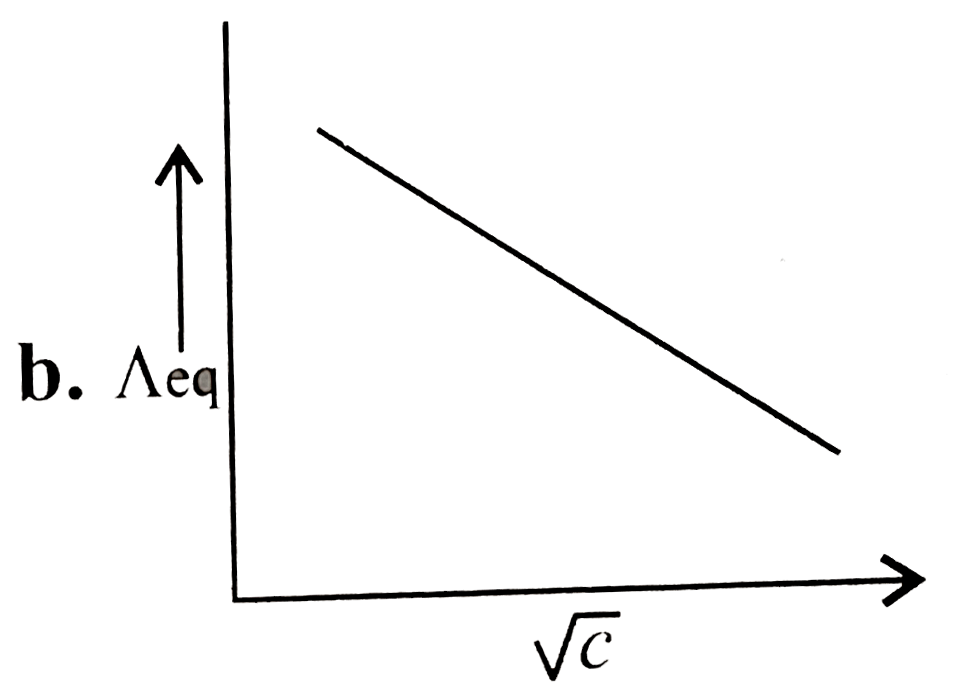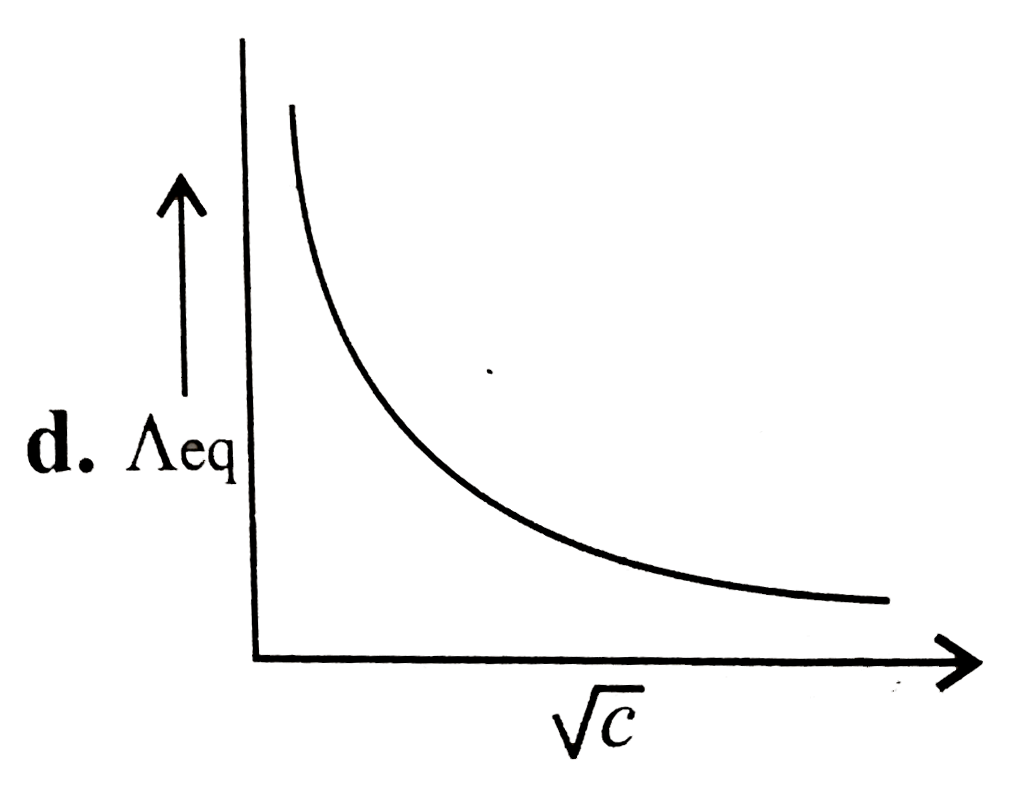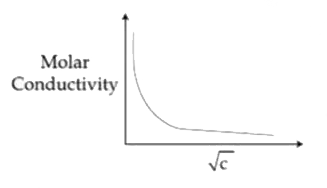The variation equivalent conductance of stronge electrolyte with is correctly shown in the figure.




The correct Answer is:b
To solve the problem regarding the variation of equivalent conductance of a strong electrolyte with the square root of concentration, we can follow these steps:
1. Understand the Relationship: The relationship between equivalent conductance (λ) and concentration (C) for strong electrolytes is given by the Debye-Hückel-Onsager equation:
λequivalent=λ0−b√C
where:
- λequivalent is the equivalent conductance at a given concentration.
- λ0 is the equivalent conductance at infinite dilution.
- b is a constant.
- C is the concentration.
2. Identify the Form of the Equation: Rearranging the equation gives us:
λequivalent=λ0−b√C
This is a linear equation of the form y=mx+c, where:
- y is λequivalent.
- x is √C.
- The slope m is negative (-b), and the y-intercept c is λ0.
3. Graph Characteristics: Since the slope is negative, the graph of equivalent conductance versus the square root of concentration will be a straight line that slopes downwards. This indicates that as the concentration increases, the equivalent conductance decreases.
4. Analyze the Options: Given the four figures, we need to identify which one represents a straight line with a negative slope.
5. Select the Correct Option: After analyzing the figures, we find that only one of them (let's say option B) shows a straight line with a negative slope, confirming that it correctly represents the relationship described by the Debye-Hückel-Onsager equation.
Conclusion:
The correct answer is option B, which shows the variation of equivalent conductance of a strong electrolyte with the square root of concentration as a straight line with a negative slope.
---
λequivalent=λ0−b√C
where:
- λequivalent is the equivalent conductance at a given concentration.
- λ0 is the equivalent conductance at infinite dilution.
- b is a constant.
- C is the concentration.
λequivalent=λ0−b√C
This is a linear equation of the form y=mx+c, where:
- y is λequivalent.
- x is √C.
- The slope m is negative (-b), and the y-intercept c is λ0.
The correct answer is option B, which shows the variation of equivalent conductance of a strong electrolyte with the square root of concentration as a straight line with a negative slope.
Topper's Solved these Questions
- ELECTROCHEMISTRYBOOK - CENGAGE CHEMISTRY ENGLISHCHAPTER - ELECTROCHEMISTRYEXERCISE - Exerciseassertion -Reasoning
25 Videos
- ELECTROCHEMISTRYBOOK - CENGAGE CHEMISTRY ENGLISHCHAPTER - ELECTROCHEMISTRYEXERCISE - Exerciseinterger
8 Videos
- ELECTROCHEMISTRYBOOK - CENGAGE CHEMISTRY ENGLISHCHAPTER - ELECTROCHEMISTRYEXERCISE - Exercisemultiple Correct Ansers
53 Videos
- D AND F BLOCK ELEMENTSBOOK - CENGAGE CHEMISTRY ENGLISHCHAPTER - D AND F BLOCK ELEMENTSEXERCISE - Archives Subjective
29 Videos
- GENERAL PRINCIPLES AND PROCESS OF ISOLATION OF ELEMENTSBOOK - CENGAGE CHEMISTRY ENGLISHCHAPTER - GENERAL PRINCIPLES AND PROCESS OF ISOLATION OF ELEMENTSEXERCISE - Archives (Subjective)
14 Videos
Similar Questions
The equivalent conductance of strong electrolyte:
View SolutionThe conductivity of a strong electrolyte:
View SolutionAn increase in equivalent conductance of a strong electrolyte with dilution is mainly due to:
View SolutionThe molar conductivity of strong electrolyte
View SolutionThe increase in equivalent conductivity of a weak electrolyte with dilution is due to :
View SolutionThe plot of molar conductance vs √C in strong electrolyte , is
View SolutionThe minimum equivalent conductance in fused state is shown by-
View SolutionThe variation of molar conductivity wih concentration of an electrolyte (X) in aqueous solution is shown in the given figure .

The electrolyte X is :
View SolutionExplain with a graph the variation of molar conductivity of a strong electrolyte with dilution.
View SolutionStatement-I: Equivalent conductance of all electrolytes decreases with increasing concentration.
Because Statement-II: Lesser number of ions ate available per gram equivalent at higher concentration.
View Solution
